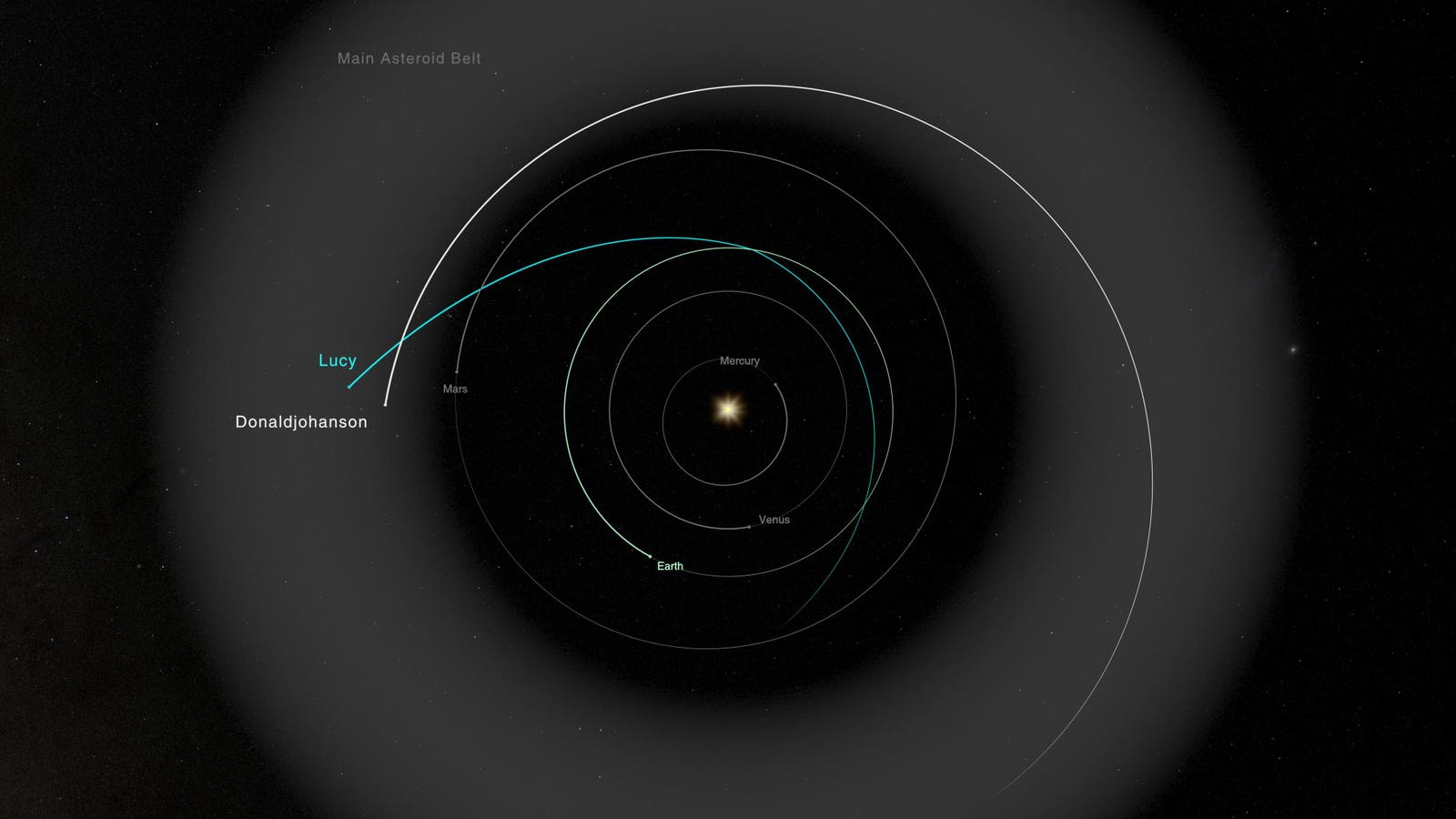Topline
NASA’s Lucy spacecraft has successfully completed a flyby of a three-mile-wide asteroid between Mars and Jupiter. Called (52246) Donaldjohanson, it’s the second of 11 asteroids the spacecraft will visit in the remaining eight years of its epic mission.
A top-down view of the inner solar system, showing Lucy’s path as it passes Donaldjohanson in the … More Asteroid Belt.
Key Facts
According to NASA, Lucy flew within 596 miles (960 kilometers) of the three-mile-wide asteroid on Sunday, April 20, at 1:51 p.m. EDT. Lucy had to shield its sensitive instruments from intense sunlight during the flyby. It ceased tracking the asteroid 40 seconds before its closest approach to prevent its cameras from being damaged.
“Initial information indicates that the spacecraft is in good health,” stated NASA in a blog post after the spacecraft reestablished contact with Earth a few hours after its closest approach. “The team has commanded the spacecraft to start sending the data collected during the encounter back to Earth.” It’s expected to take up to a week for the first images to emerge.
Donaldjohanson is thought to have been sliced off a bigger asteroid about 150 million years ago and rotate every 251 hours. It’s thought to be carbon-rich and be about 2.5 miles (4 kilometers) in diameter. It orbits the sun in the solar system’s Main Asteroid Belt.
The aim of Lucy’s flyby was to test the spacecraft and make sure its scientists are well prepared for the mission’s main target — the Jupiter Trojan asteroids, which it will make its first visit to in 2027. No Trojan asteroid has been visited before.
Trojan asteroids are a group of primordial bodies that orbit the sun in two distinct groups, both behind and ahead of Jupiter. Often called “Jupiter’s children,” Trojans are thought to be fossils from the formation and evolution of the planets and the solar system.
Lucy’s Journey So Far
This is the second asteroid flyby by Lucy since its launch in 2021. The last one, Dinkinesh, was imaged in Nov. 2023, after which it was realized to have a satellite asteroid in orbit. It was later named Selam. Donaldjohanson is thought to be a relatively young object that periodically brightens and dims every 10 days, which suggests that it’s an elongated shape and rotates.
“The warm-up asteroids are proving to be quite interesting in their own right,” said Dr. Hal Levison, principal investigator of the Lucy mission at the Southwest Research Institute in San Antonio, Texas, who called Donaldjohanson a “peculiar” object.
What’s Next For Lucy
During its mission, Lucy will orbit the sun six times and visit eight Trojan asteroids through 2033. Its next target is Eurybates and its satellite Queta, which it will fly by on Aug. 12, 2027. A month later, on Sept. 15, 2027, it will fly by Polymele and its satellite, with further flybys in 2088 and 2033.
Although it will return to Earth for gravity assists during its mission, Lucy will never come back for good. Instead, it will travel between the Trojan asteroids and the orbit of the Earth for millions of years. To that end, it contains a time capsule with messages from people including Albert Einstein, Carl Sagan, Martin Luther King Jr. and all four members of The Beatles.
Background
The Lucy spacecraft is named after the nickname given to the fossilized hominin — a human ancestor — discovered in Afar, Ethiopia, in 1974, in sediment known to be 3.2 million years old. Named for the Beatles song “Lucy in the Sky with Diamonds,” in Ethiopia, the fossil is called Dinkinesh, which led to the name given to the NASA spacecraft’s first target. Asteroid (52246) Donaldjohanson is named after the paleoanthropologist who unearthed Lucy/Dinkinesh just over fifty years ago.
Further Reading
ForbesNorthern Lights Tonight: How To Take Photos With A Phone — Expert TipsBy Jamie Carter
ForbesLyrid Meteor Shower ‘Fireballs’ To Peak Monday — Exactly When To WatchBy Jamie CarterForbesHalley’s Comet Meteor Shower Starts This Weekend — Here’s When To WatchBy Jamie Carter









